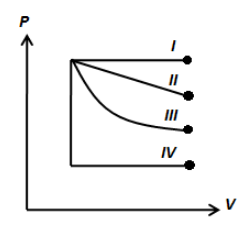
Figure shows four indicator diagrams. In which case is the work done maximum?

A.
B.
C.
D.

Answer
478.2k+ views
Hint: In isothermal, reversible process, the temperature remains constant. In that case, the work done is given by the area under the curve in the PV diagram. The area under the curve is the maximum for the process which involves more pressure.
Complete answer:
In thermodynamics, when the state of the gas changes to A to B, the work done involve in this process is expressed as,
Here, P is the pressure of the gas and
We know that in an isothermal, reversible process, the temperature remains constant. In that case, the work done simply given by the area under the curve in the PV diagram.
If we look at the figure shown above, we can easily deduce that the area under the curve traced by I has more area than the rest of the curves. Therefore, the work done in the process followed by I is the maximum.
Thus, the correct answer is option D.
Additional information:
We can express the ideal gas equation as,
Therefore, work done by the gas is can be expressed as,
Note: The process followed by I and IV is the isobaric process where the pressure does not change. The process followed by II may be an isothermal process. However, the work done involved in each process is the area under the curve and the area under the curve is the maximum when the pressure is the maximum.
Complete answer:
In thermodynamics, when the state of the gas changes to A to B, the work done involve in this process is expressed as,
Here, P is the pressure of the gas and
We know that in an isothermal, reversible process, the temperature remains constant. In that case, the work done simply given by the area under the curve in the PV diagram.
If we look at the figure shown above, we can easily deduce that the area under the curve traced by I has more area than the rest of the curves. Therefore, the work done in the process followed by I is the maximum.
Thus, the correct answer is option D.
Additional information:
We can express the ideal gas equation as,
Therefore, work done by the gas is can be expressed as,
Note: The process followed by I and IV is the isobaric process where the pressure does not change. The process followed by II may be an isothermal process. However, the work done involved in each process is the area under the curve and the area under the curve is the maximum when the pressure is the maximum.
Latest Vedantu courses for you
Grade 7 | CBSE | SCHOOL | English
Vedantu 7 CBSE Pro Course - (2025-26)
School Full course for CBSE students
₹45,300 per year
Recently Updated Pages
Master Class 9 General Knowledge: Engaging Questions & Answers for Success

Master Class 9 English: Engaging Questions & Answers for Success

Master Class 9 Science: Engaging Questions & Answers for Success

Master Class 9 Social Science: Engaging Questions & Answers for Success

Master Class 9 Maths: Engaging Questions & Answers for Success

Class 9 Question and Answer - Your Ultimate Solutions Guide

Trending doubts
State and prove Bernoullis theorem class 11 physics CBSE

What are Quantum numbers Explain the quantum number class 11 chemistry CBSE

Who built the Grand Trunk Road AChandragupta Maurya class 11 social science CBSE

1 ton equals to A 100 kg B 1000 kg C 10 kg D 10000 class 11 physics CBSE

State the laws of reflection of light

One Metric ton is equal to kg A 10000 B 1000 C 100 class 11 physics CBSE




